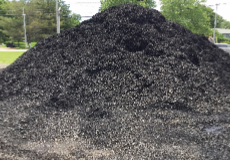
All mulch is not the same and Pearson's Family Hardware & Supply mulch is the best there is. We start with virgin wood fibers; a blend of cedar, hemlock, pine, and other native woods. In the mulch production process we use the best environmentally safe colorant available and state of the art equipment to assure 100% perfection in every cubic yard.
The first step in mulching your landscape beds is “planning”
Walk around your property and first decide which beds you want to mulch. Measure the approximate square ft of the beds by multiplying the bed width by the bed length. The most common calculation to remember is that 1 cubic yard of mulch will cover approximately 100 sq ft of area at a depth of 3”, the recommended depth.
The second step is to prepare the beds to be properly mulched
Edge all the beds with an edging tool to a depth of 3”. Cultivate weeds and old mulch into the soil of the bed. Rake the bed area smooth, remembering to pitch soil away from the house foundation for proper drainage. Apply PREEN or other brand weed pre-emergents if desired.
The final step is to apply the mulch at a finished depth of 3”
A 3” depth ensures that the soil will be kept cool and moist in the summer and warm in the winter. You will need a wheelbarrow, pitch fork and flat shovel for loading the mulch and transporting it from your driveway to the beds. After the mulch is dumped in piles throughout the bed you will need an iron rake and leaf rake for the spreading of the mulch. Use the iron rake to rough spread the mulch. Then take your leaf rake and turn it upside down. Use the upside down leaf rake to feather the mulch throughout the beds to give it a true professionally finished look.
Helpful Hints:
Plan on weeding your beds once a month. The mulch should suppress the majority of weeds, but use a herbicide such as Roundup to eliminate the strongest culprits. After months of rain and sun exposure, the mulch may start to lose its luster in appearance. It is suggested to take delivery of a reduced order of mulch and lightly top dress your beds to give a professionally finished look. Lastly, sit back and enjoy the warm weather months in a refreshing landscape setting. For best results allow dyed mulch 24 hours to set prior to rain. * Stop in and see an Associate for further mulch and landscape questions.
Hours:
Mon - Sat: 8am - 5pm
Delivery Available
